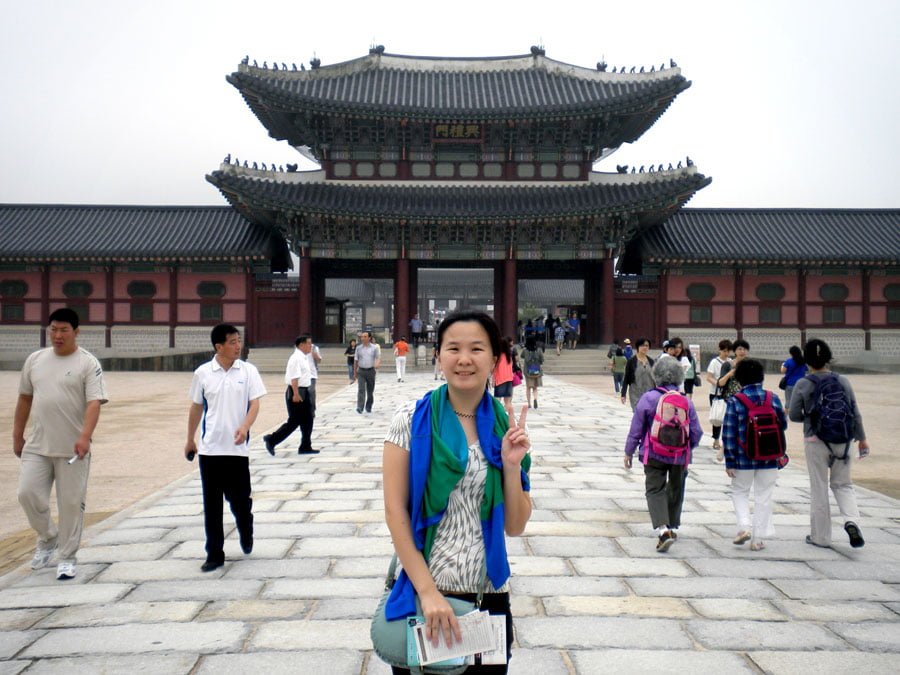While Seoul is a pretty modern and vibrant metropolis today, it’s easy to go back in time when some of its most precious historical architecture is located right in the middle of the city. The first place I visited on my first solo trip to Seoul was Gyeongbokgung, the largest of the old palaces that you can still find in Seoul.
Gyeongbokgung was significant because it was the main or legal palace where the King lived, making it the most important of all the palaces.
Royal Guard Changing Ceremony 수문장 교대의식
Most people try to catch the famous guard changing ceremony at 10am – I got there a little late so I only caught the very tail-end of it, but if you hang around the main gate of Gwanghwamun, you might still catch the guards shifting positions every so often.
I caught the free English tour at 11am, conducted by a cute little Korean lady dressed in the traditional Hanbok. Her English was pretty good and she was very earnest and informative, a great guide all around. The tour takes you around the Joseon Dynasty style architecture, to the throne hall Geunjeongjeon where main court business was conducted – look out for the King’s throne with a painting of the sun (representing the King), moon (Queen) and mountains (for Korea) on it.
Colourful Dancheong 단청
What intrigued me were the really vibrant colours that you could see on the underside of the roofs. These 5 paint colours (blue, red, yellow, white, black… I did see a lot of green though) are known as Dancheong and meant to represent each of the 5 natural elements. They are often found in palaces and temples, meant to protect the wooden buildings from insects and weather damage, but the designs often incorporate symbols to prevent fire and evil spirits as well.
The Japsang 잡상 Guardians
Also, look out for the little animals on the rooftops of the buildings – these are called Japsang and are a Chinese influence, inspired by the characters from the tale ‘Journey to the West’ and meant for protection – the more figures there are, the more important the building.
Inner Sanctums
As with most palaces, there are some inner areas that are hidden from the public where the royal folk could go hang out and relax.
Tourist Info
- Hours: 9am – 5pm (nov-feb) / 6pm (mar-oct)
- Closed on Tuesdays
- Free English tours: 11am, 130pm, 330pm, lasts about an hour.
- Tours in Japanese and Chinese also available! I recommend you do a tour if you don’t speak Korean, it really makes the place come alive more
- Admission Fee: 3,000 won
- You can get a combined ticket for 10,000 won if you plan to visit the other palaces. If you plan to do Changdeokgung and the Secret Garden, I suggest you get this ticket as that tour (CDG + secret garden) costs 8,000 won in total
Getting There
Gyeongbokgung can be accessed via Subway (Gyeongbokgung station, Line 3, Exit 5). The subway is interesting as its lined by some artwork and looks like the walls of the fortress above
Around the area
- Also on the premises and free!:
- National Palace Museum of Korea (Closed on Mondays, which was the day I visited!)
- National Folk Museum of Korea (Looks like a pagoda outside, very modern on the inside, nice looking museum but I walked it pretty quickly and mainly enjoyed it for the aircon on that hot day)
- East: I walked to Samcheongdong (an upscale indie sorta neighbourhood) and then the Bukchon Hanok (residential area made up of old Korean style houses) after my Gyeongbokgung tour
- Changdeokgung, the other palace I visited is on the other side of the Bukchon Hanok, it’s possible to do both palaces in the same day, but note that Changdeokgung is closed on Mondays.
- South: the artsy area Insadong is walkable from the palace, I walked to Insadong after I was done with Samcheongdong and Bukchon Hanok
- Also nearby if you’re tired of palaces: Jogyesa (A buddhist temple in the middle of the city next to Insadong)
- Gwanghwamun Square lies in front of the main Gwanghwamun gate. A giant statue of King Sejong the great, his admiral and a fountain line this open plaza
Looking for more posts on Seoul? Why not see where else there is to visit in South Korea?





